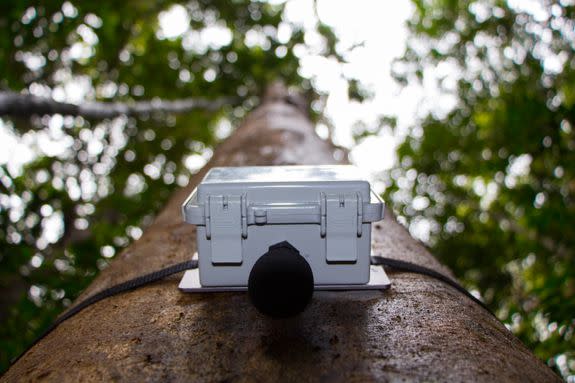Audio recorded inside rainforests reveals a rowdy symphony of nature

The deep rainforest is a symphony.
In the rainforests of Indonesia, New Guinea, and other wild lands, scientists strapped microphones to trees and recorded the boisterous howls, grumbles, and shrieks that echo through the woods. It's called bioacoustics, and in a new paper published Thursday in the journal Science, researchers highlighted the value of using recorded wild sound — which you can hear below — to gauge how animals are doing in both vulnerable and protected forests.
Modern satellite images certainly give detailed images of the forest canopies, and have proven valuable in grasping the health of rainforests. But they don't tell you what's happening to the creatures underneath the thick canopy — many of whom are vulnerable to hunting and overexploitation.
"This takes you to the next level," Rhett Butler, a conservationist journalist and one of the paper's authors, said of bioacoustics "You get a much bigger picture."
As the recordings below illustrate, rainforest environments can produce walls of sound teeming with diverse pitches and calls. It's a wild metropolis.
"A wall is a good way to describe it," said Butler, the CEO of Mongabay, a nonprofit media and conservation organization. "Animals have evolved so that they call in certain frequencies, so they don’t drown each other out."
The first example comes from a protected, never logged forest in Berau, Indonesia.
Some forests, however, might appear quite intact and healthy from the view of satellites. But this can be deceiving. Forest fires can burn through the drought-ridden understory, the jungles may be overrun with invasive species, or certain critters might simply be gone.
This is especially the case near logging roads, which can invite hunting.
"You can put devices where there’s logging or roads and hunting, and you can notice certain species disappear," said Butler.

Image: Justine E. Hausheer / TNC
Even plantations or areas near plantations can sustain bounties of life — though an expert ear can spot missing species.
"It’s a monotonous sound rather than the full symphony," said Butler.
SEE ALSO: These are the animals that went extinct in 2018
Below is a recording from an acacia plantation in the rainforest of Berau Indonesia. An acacia plantation is a planted forest, which is harvested for wood.
The following three-minute track is from the Musiamunat community conservation area in Papua New Guinea.
Today, vast swaths of rainforest are actively deforested to make way for crops and provide land for cattle. It's a challenging scenario, as deforestation is not just driven by industry: Often farmers living in extreme poverty deforest the land, just so they can feed themselves.
According to Mongabay, between 2000 and 2005, Brazil alone lost an area of forest larger than the nation of Greece.
What's more, rainforests play an outsized role sustaining a stable climate on Earth. These ecosystems naturally absorb carbon dioxide — a potent greenhouse gas — from the air. Though conserving rainforests isn't nearly the sole remedy to mitigating human-caused climate change, which is now advancing at an accelerated pace, these ancient forests are a critical part the solution.
The planet's carbon dioxide levels are now the highest they've been in 15 million years.
WATCH: Ever wonder how the universe might end?


